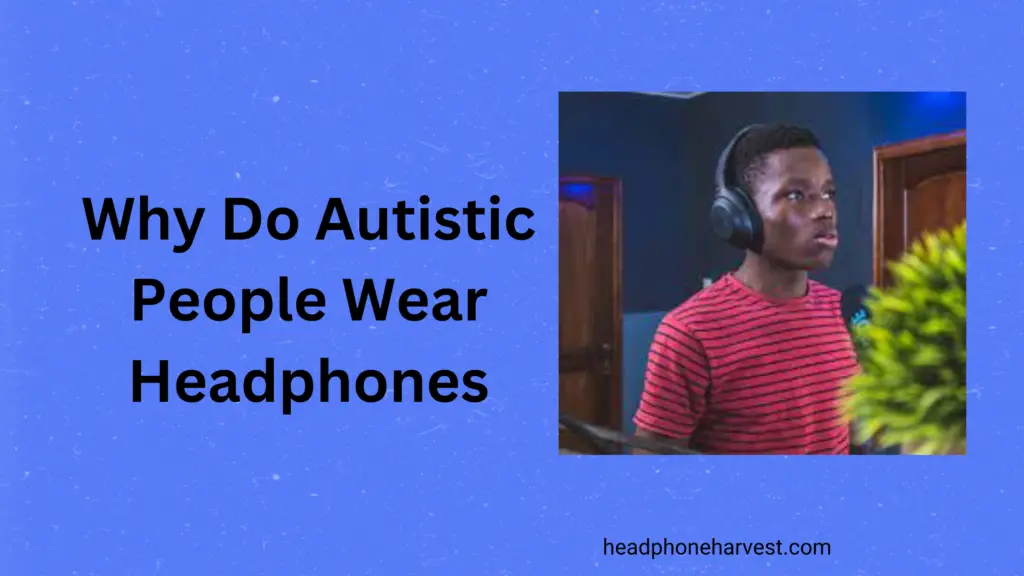Dive into the world of sensory sensitivities in autism and uncover Why Do Autistic People Wear Headphones. Explore the empowering role of headphones in sensory regulation and communication, creating a safe sonic space. Learn how understanding and respecting this choice fosters inclusivity.
In the vibrant tapestry of neurodiversity, the choice of many autistic individuals to wear headphones is not merely a fashion statement but a profound coping mechanism. This article explores the multifaceted reasons behind this behavior, shedding light on the unique sensory experiences of autistic individuals and why headphones play a crucial role in their daily lives. From sensory sensitivities to communication challenges, we delve deep into the world of those on the autism spectrum, aiming to create a comprehensive resource that promotes understanding and acceptance.
You Can Read More about our Product Reviews: Nipell Wireless Earbuds Review in 2024
Why Do Autistic People Wear Headphones
Autistic individuals wear headphones to manage sensory sensitivities, creating a comfortable and controlled environment by regulating auditory input. It’s a practical coping mechanism fostering empowerment and inclusivity.
Sensory Sensitivities in Autism

Autism spectrum disorder (ASD) is characterized by a diverse array of symptoms and traits, with sensory sensitivities being a hallmark feature. Autistic individuals often experience heightened sensitivity to external stimuli, including sounds, lights, textures, and more. This heightened sensitivity can make everyday environments overwhelming and distressing. Headphones become a valuable tool in managing these sensory challenges, providing a shield against the unpredictable and sometimes jarring sounds of the surrounding world.
The Power of Sound in Sensory Regulation

For many autistic individuals, sound is a significant factor in their sensory experiences. Headphones, in this context, serve as a powerful tool for regulating auditory input. By wearing headphones, individuals with autism can control and modulate the sounds around them, creating a more comfortable and predictable auditory environment. This ability to manage sound intake can be empowering, offering a way to navigate social situations, public spaces, and daily routines more comfortably.
Creating a Safe Sonic Space

Beyond sound reduction, the act of wearing headphones contributes to the creation of a safe and predictable space for those with autism. In a world that may bombard them with unexpected and intense stimuli, headphones become a means of carving out a personal sanctuary. This safe space allows for engagement with the environment on their terms, fostering a sense of security and reducing anxiety.
Communication Challenges and the Role of Headphones
Communication difficulties are another significant aspect of autism, and the use of headphones can play a role in navigating these challenges. Autistic individuals may use headphones as a non-verbal signal, indicating to others that they are currently regulating sensory input or may find it challenging to engage in conversation. Understanding and respecting this non-verbal communication can contribute to more positive and inclusive interactions.
Advocacy and Support

Advocacy for autism acceptance and support is crucial in fostering a more inclusive society. This section explores ongoing efforts by advocacy groups, individuals, and initiatives working towards creating a world that acknowledges and accommodates sensory sensitivities. By amplifying the voices of the autism community, we can work towards dismantling stigmas and building a more compassionate and understanding world for everyone.
Conclusion:
In conclusion, the act of wearing headphones by autistic individuals is deeply rooted in the need for sensory regulation and creating a sense of safety in a world that may not always align with their unique experiences. By understanding and appreciating the reasons behind this behavior, society can foster empathy, promote inclusivity, and create an environment that celebrates neurodiversity. This comprehensive exploration aims to contribute to a more compassionate and informed dialogue surrounding autism and the use of headphones, ultimately striving towards a world that embraces and accommodates the diverse strengths and perspectives of individuals on the spectrum.
FAQs:
How do autistic people calm themselves?
Autistic individuals often use various coping mechanisms to calm themselves. These can include sensory tools like headphones, weighted blankets, or fidget toys. Some may prefer routines and predictability, engaging in activities that provide a sense of familiarity and comfort. Calming strategies are diverse and unique to each individual.
What is the average lifespan of a person with autism?
Autism itself does not impact lifespan. However, associated health conditions or challenges in areas like communication and safety awareness may influence outcomes. With appropriate support, many individuals with autism lead fulfilling lives with a lifespan comparable to the general population.
Why do mentally challenged individuals wear headphones?
Individuals with intellectual or developmental disabilities, including those who are mentally challenged, may wear headphones to manage sensory sensitivities. Like autistic individuals, they might find comfort in reducing external stimuli, creating a more controlled auditory environment to navigate the world more comfortably.
